UnitedHealth Group Bundle
Can UnitedHealth Group Continue Its Healthcare Dominance?
Founded in 1977, UnitedHealth Group has evolved from a managed care startup into a healthcare behemoth. With 2024 revenues exceeding $400 billion, the company's influence in the healthcare industry is undeniable. Its integrated approach, combining UnitedHealthcare and Optum, positions it uniquely in a complex market. Understanding the UnitedHealth Group SWOT Analysis is crucial to grasping its trajectory.
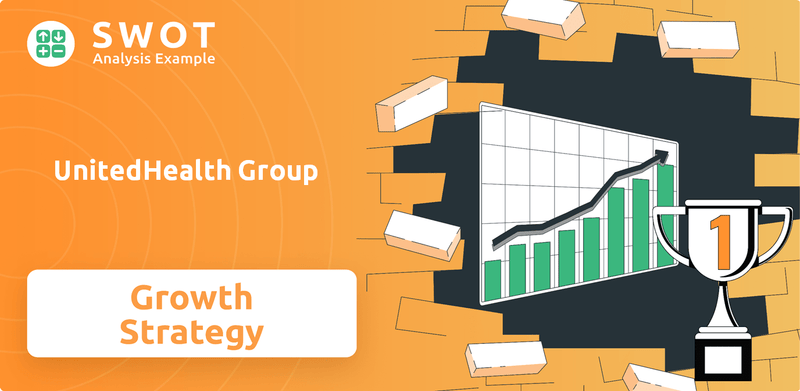
This exploration delves into the UnitedHealth Group's growth strategy and future prospects, providing a detailed market analysis of its financial performance and strategic initiatives. We'll examine how UnitedHealth Group is navigating the ever-changing healthcare industry, evaluating its expansion plans, and assessing its long-term growth potential. This analysis offers valuable insights for investors and strategists looking to understand the dynamics of this healthcare giant.
How Is UnitedHealth Group Expanding Its Reach?
The Growth Strategy of UnitedHealth Group is significantly shaped by its expansion initiatives. These initiatives focus on both increasing its market presence and diversifying its business operations. This approach is crucial for navigating the dynamic Healthcare Industry and ensuring sustained Financial Performance.
UnitedHealth Group continually seeks avenues to broaden its reach and enhance its service offerings. This includes strategic moves to attract new customers and adapt to the evolving landscape of the healthcare sector. The company's commitment to growth is evident in its investments and strategic decisions.
In 2024, UnitedHealthcare expanded its state customer relationships in several states, including Michigan, Idaho, Nevada, and Georgia. This expansion is designed to increase the number of members served in 2025. The company also saw a rise in consumers served with self-funded commercial benefits in the first quarter of 2025, indicating a positive response to its innovative offerings.
Optum Health, a key segment of UnitedHealth Group, is set to grow its value-based care patient base. The company anticipates serving 650,000 new value-based care patients in 2025. By the end of 2025, Optum Health projects to have approximately 5.4 million value-based care patients.
UnitedHealth Group actively pursues acquisitions to strengthen its market position. In 2024, the company made approximately $13 billion in acquisitions. These acquisitions are primarily focused on enhancing service offerings and expanding market reach. For a deeper understanding of their target customer base, consider exploring the Target Market of UnitedHealth Group.
UnitedHealth Group's expansion efforts are driven by several factors. These include accessing new customer segments and diversifying revenue streams. The company also aims to adapt to industry changes, such as shifts in Medicare Advantage and Medicaid redeterminations.
- Market Penetration: Expanding services within existing markets.
- Diversification: Broadening service offerings to reduce reliance on any single area.
- Adaptation: Responding to changes in healthcare regulations and consumer needs.
- Strategic Investments: Allocating capital to acquisitions and internal growth projects.
UnitedHealth Group SWOT Analysis
- Complete SWOT Breakdown
- Fully Customizable
- Editable in Excel & Word
- Professional Formatting
- Investor-Ready Format
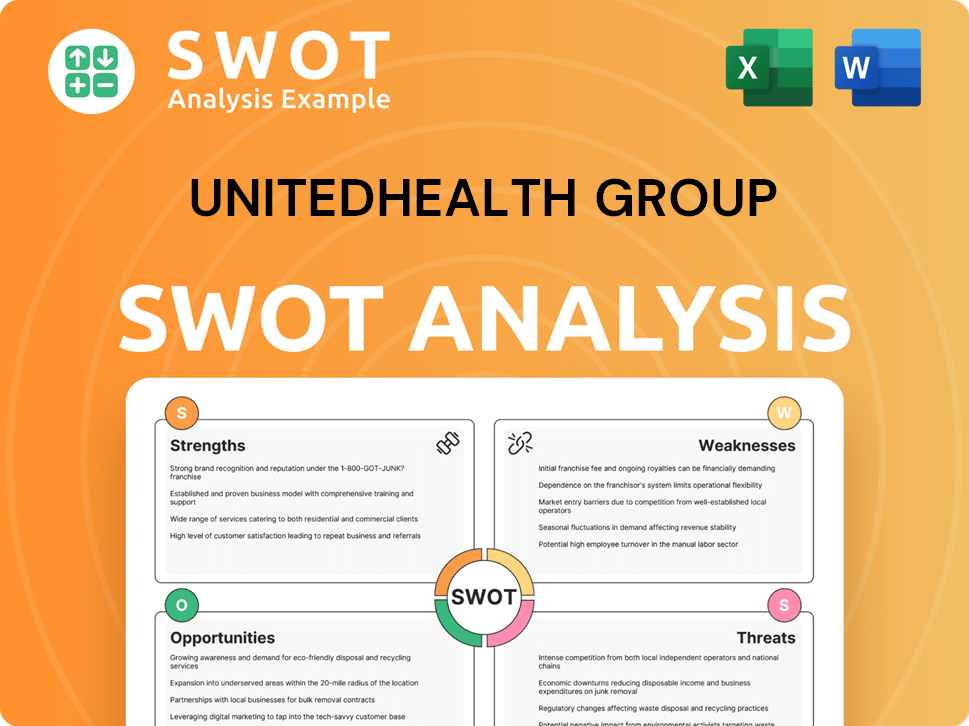
How Does UnitedHealth Group Invest in Innovation?
UnitedHealth Group (UHG) heavily invests in technology and innovation, viewing them as crucial for sustained growth within the Healthcare Industry. The company's strategic focus on these areas is evident through its substantial annual investments, exceeding $8.5 billion in innovation, research, and development. This commitment underscores UHG's dedication to staying at the forefront of technological advancements to improve its services and market position.
The company's approach involves a significant expansion in the use of artificial intelligence (AI) across its operations. UHG has integrated AI into various segments, including insurance, health delivery, and pharmacy services. This strategic deployment of AI is designed to enhance efficiency, improve customer service, and optimize healthcare outcomes. The company's focus on digital transformation aims to fully implement AI and automation capabilities by 2025.
UHG's strategic use of AI and digital transformation is a key component of its Growth Strategy, aiming to enhance its services and market position. The company also focuses on expanding virtual care capabilities and leveraging data analytics to improve health outcomes. This forward-thinking approach is central to UHG's vision for 2025, emphasizing innovation and customer experience.
UHG currently has approximately 1,000 AI applications in production across its various segments. These applications are designed to streamline operations, improve patient care, and enhance customer service. Another 1,000 AI tools are in development, indicating a continued commitment to leveraging AI.
These AI tools are used for various tasks, including transcribing clinician visits, summarizing medical data, automating claims processes, and powering customer-facing chatbots. They also assist engineers in software development. An AI tool handled 18 million queries in Q1 2025.
Generative AI is used to gather supplemental data for claims that cannot be auto-adjudicated. This affects about 10% of claims. This helps streamline the claims process and improve accuracy.
In its Optum health delivery unit, AI tools assist doctors in identifying potentially undiagnosed conditions. Early results showed clinicians were twice as effective with AI aid. This demonstrates the impact of AI on improving healthcare outcomes.
UHG aims to fully implement AI and automation capabilities by 2025. This initiative is designed to ensure more efficient service delivery and cost management. This digital transformation is a core part of their strategic plan.
UnitedHealthcare is also focusing on expanding virtual care capabilities and leveraging data analytics to improve health outcomes. These efforts align with UHG's broader vision centered on innovation and customer experience for 2025. This strategy is a key element of the company's future investment opportunities.
UHG's strategic initiatives are centered around technology and innovation, with a significant focus on AI and digital transformation. These efforts are designed to enhance operational efficiency, improve customer service, and drive better health outcomes. The company's commitment to these areas is evident in its substantial investments and the widespread integration of AI across its various business segments.
- AI Integration: Deploying AI across insurance, health delivery, and pharmacy segments to automate processes and improve decision-making.
- Digital Transformation: Aiming for full implementation of AI and automation by 2025 to streamline operations and reduce costs.
- Virtual Care Expansion: Expanding virtual care capabilities to improve accessibility and patient outcomes.
- Data Analytics: Leveraging data analytics to gain insights and improve the effectiveness of healthcare services.
- Innovation Investment: Continuing to invest over $8.5 billion annually in innovation, research, and development to stay at the forefront of technological advancements.
For a deeper understanding of the competitive landscape, consider exploring the Competitors Landscape of UnitedHealth Group. This analysis provides valuable insights into the market dynamics and the challenges and opportunities UHG faces.
UnitedHealth Group PESTLE Analysis
- Covers All 6 PESTLE Categories
- No Research Needed – Save Hours of Work
- Built by Experts, Trusted by Consultants
- Instant Download, Ready to Use
- 100% Editable, Fully Customizable
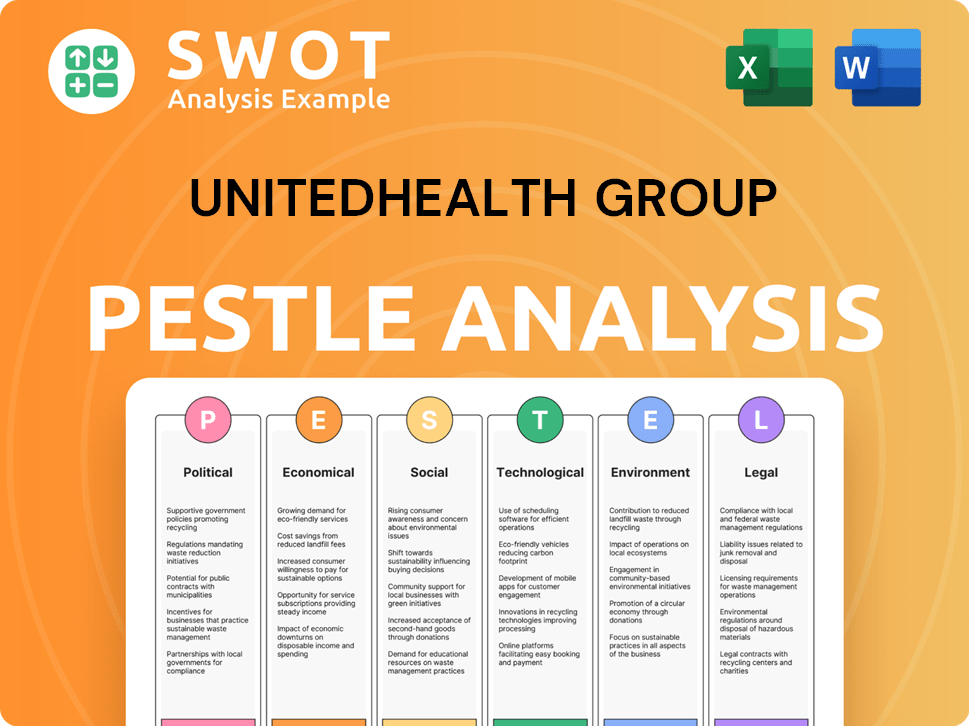
What Is UnitedHealth Group’s Growth Forecast?
The financial outlook for Owners & Shareholders of UnitedHealth Group has seen revisions for 2025. Initially, the company projected strong performance, but subsequent developments led to adjustments. These changes reflect the dynamic nature of the healthcare industry and the importance of adapting to evolving market conditions. Understanding these revisions is critical for assessing the company's future prospects.
In December 2024, the company initially provided a positive outlook for 2025. The initial forecast included anticipated revenues and earnings per share. However, after the first quarter of 2025, these figures were updated. The revisions highlight the impact of increased care activity and changes within the company's business segments.
Despite the adjustments, the company continues to demonstrate robust financial performance. The first-quarter 2025 results show significant revenue growth. This growth, alongside improvements in the net margin, indicates the company's resilience and ability to navigate challenges. This performance is a key indicator of the company's ability to execute its growth strategy.
The company initially projected revenues between $450 billion and $455 billion for 2025. The initial adjusted net earnings per share were estimated to be between $29.50 and $30.00.
After Q1 2025, the company revised its net earnings forecast to $24.65 to $25.15 per share. Adjusted earnings were adjusted to $26 to $26.50 per share. These revisions reflect the company's responsiveness to market dynamics.
Revenues for Q1 2025 were $109.6 billion, a 9.8% increase year-over-year. Operating earnings for the quarter were $9.1 billion. The net margin improved to 5.7% from a negative 1.4% in the prior year.
The company generated $21 billion in free cash flow in 2024. Over $16 billion was returned to shareholders through dividends and share repurchases in 2024. The company is focused on delivering value to its shareholders.
Several factors influenced the revision of the 2025 financial outlook. These include heightened care activity in Medicare Advantage businesses and changes in Optum Health member profiles. These factors underscore the importance of adaptability in the healthcare industry.
- Increased care activity in UnitedHealthcare's Medicare Advantage businesses, which grew at twice the anticipated rate.
- Unanticipated changes in the profile of Optum Health members affected planned 2025 reimbursement.
- The company aims to return to its long-term earnings growth rate target of 13% to 16%.
UnitedHealth Group Business Model Canvas
- Complete 9-Block Business Model Canvas
- Effortlessly Communicate Your Business Strategy
- Investor-Ready BMC Format
- 100% Editable and Customizable
- Clear and Structured Layout
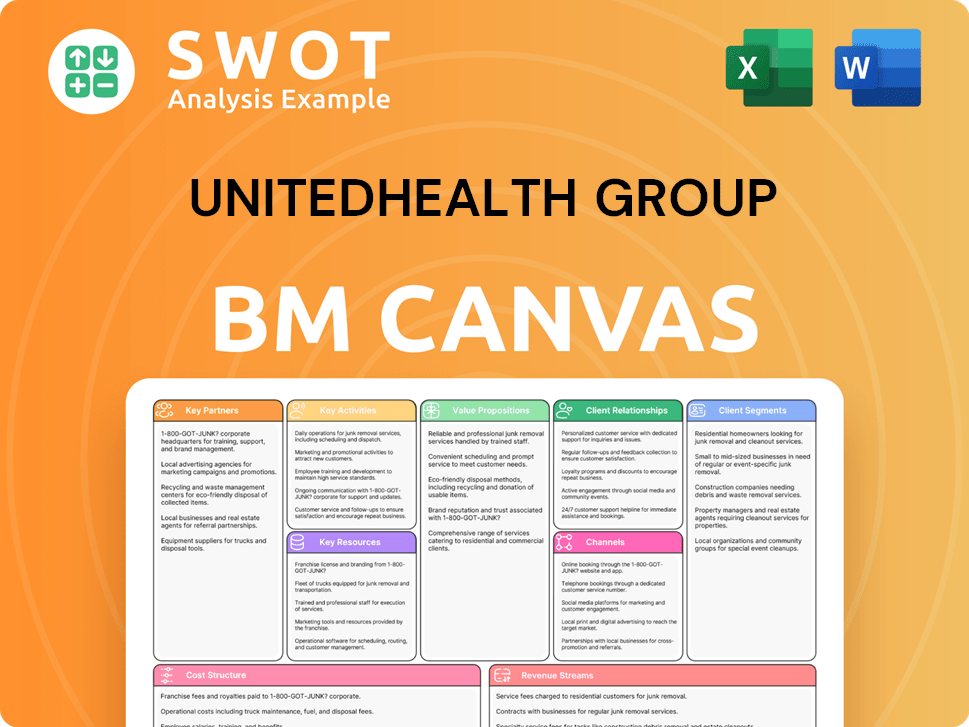
What Risks Could Slow UnitedHealth Group’s Growth?
The UnitedHealth Group faces several potential risks and obstacles that could affect its Growth Strategy and Future Prospects. These challenges range from immediate operational hurdles to long-term strategic issues, impacting its financial performance and market position within the Healthcare Industry.
A primary concern in early 2025 has been higher-than-anticipated care activity within its Medicare Advantage businesses. This has led to revisions in its 2025 earnings outlook. Additionally, changes in the profile of Optum Health members and shifts in the CMS risk adjustment model further complicate matters.
Beyond these immediate challenges, the company must navigate ongoing regulatory scrutiny and potential policy changes. Cybersecurity risks, highlighted by the Change Healthcare network outage, also pose a significant threat. Despite these hurdles, UnitedHealth Group is actively working to address these issues.
Higher-than-expected care utilization, particularly in physician and outpatient services, has directly impacted the company's financial projections for 2025. These challenges require proactive management strategies to maintain profitability. The company is focusing on optimizing care delivery and cost management within its Medicare Advantage plans.
UnitedHealth Group faces ongoing regulatory scrutiny, including a Department of Justice civil fraud probe. Changes in healthcare policy, especially during election cycles, could significantly impact its long-term growth. The company must navigate these challenges by ensuring compliance and adapting to evolving regulatory landscapes.
Cybersecurity risks, exemplified by the Change Healthcare network outage in early 2024, remain a significant concern. Protecting sensitive personal health information is crucial. The company is investing in robust cybersecurity measures to safeguard its data and systems.
There is pressure on pharmacy benefit managers (PBMs), including Optum Rx, regarding transparency around rebates and spread-based pricing. Changes in PBM practices could affect revenue streams. UnitedHealth Group is adapting to these pressures by focusing on value-based pricing and transparent practices.
Changes in the Centers for Medicare & Medicaid Services (CMS) risk adjustment model affect current and new complex patients served by Optum Health. These adjustments can influence reimbursement rates. The company is working to adapt its care models and ensure accurate risk assessments.
UnitedHealth Group's Market Analysis reveals a competitive landscape in the Healthcare Industry. Maintaining market share and expanding into new areas requires strategic planning and innovation. The company is continually evaluating its Growth Strategy to stay ahead of competitors.
UnitedHealth Group must carefully manage its Financial Performance in light of these risks. The company's ability to maintain profitability and meet its financial targets will depend on effective risk management and strategic adjustments. This includes optimizing operational efficiency and adapting to changing market conditions. For a detailed look at the company's financials, you can check out this article on UnitedHealth Group's financial performance.
UnitedHealth Group is actively implementing strategies to mitigate these risks. These initiatives include enhancing care management programs, improving operational efficiencies, and investing in cybersecurity infrastructure. Adaptations to changing market dynamics and regulatory requirements are also crucial for sustained Growth Strategy. The company's diversified business model and strong financial resources are key to its resilience.
UnitedHealth Group Porter's Five Forces Analysis
- Covers All 5 Competitive Forces in Detail
- Structured for Consultants, Students, and Founders
- 100% Editable in Microsoft Word & Excel
- Instant Digital Download – Use Immediately
- Compatible with Mac & PC – Fully Unlocked
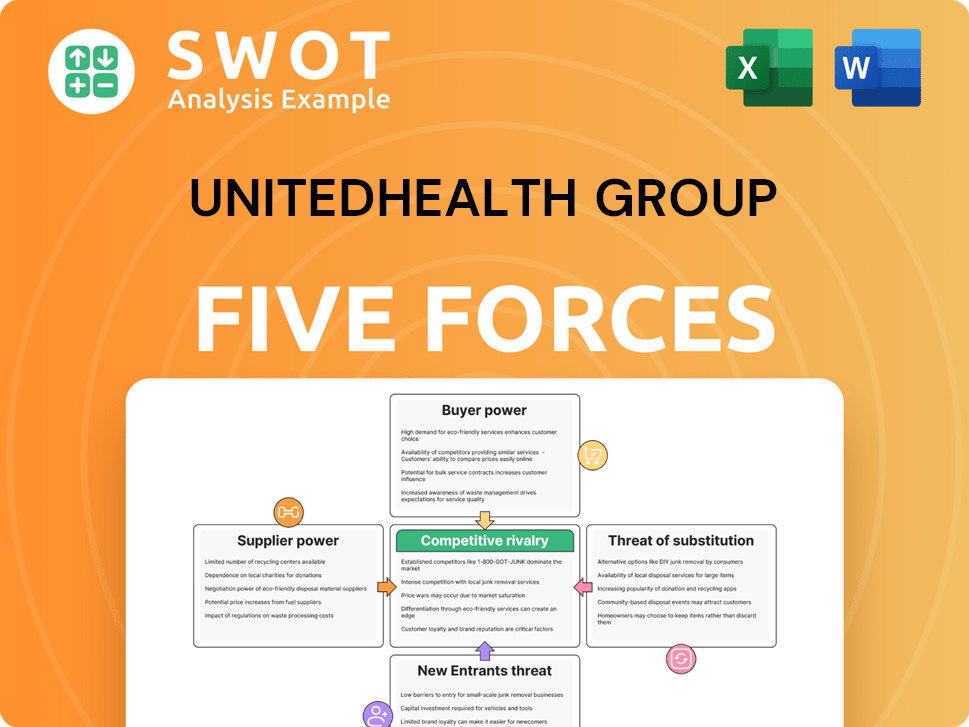
Related Blogs
- What are Mission Vision & Core Values of UnitedHealth Group Company?
- What is Competitive Landscape of UnitedHealth Group Company?
- How Does UnitedHealth Group Company Work?
- What is Sales and Marketing Strategy of UnitedHealth Group Company?
- What is Brief History of UnitedHealth Group Company?
- Who Owns UnitedHealth Group Company?
- What is Customer Demographics and Target Market of UnitedHealth Group Company?
Disclaimer
All information, articles, and product details provided on this website are for general informational and educational purposes only. We do not claim any ownership over, nor do we intend to infringe upon, any trademarks, copyrights, logos, brand names, or other intellectual property mentioned or depicted on this site. Such intellectual property remains the property of its respective owners, and any references here are made solely for identification or informational purposes, without implying any affiliation, endorsement, or partnership.
We make no representations or warranties, express or implied, regarding the accuracy, completeness, or suitability of any content or products presented. Nothing on this website should be construed as legal, tax, investment, financial, medical, or other professional advice. In addition, no part of this site—including articles or product references—constitutes a solicitation, recommendation, endorsement, advertisement, or offer to buy or sell any securities, franchises, or other financial instruments, particularly in jurisdictions where such activity would be unlawful.
All content is of a general nature and may not address the specific circumstances of any individual or entity. It is not a substitute for professional advice or services. Any actions you take based on the information provided here are strictly at your own risk. You accept full responsibility for any decisions or outcomes arising from your use of this website and agree to release us from any liability in connection with your use of, or reliance upon, the content or products found herein.